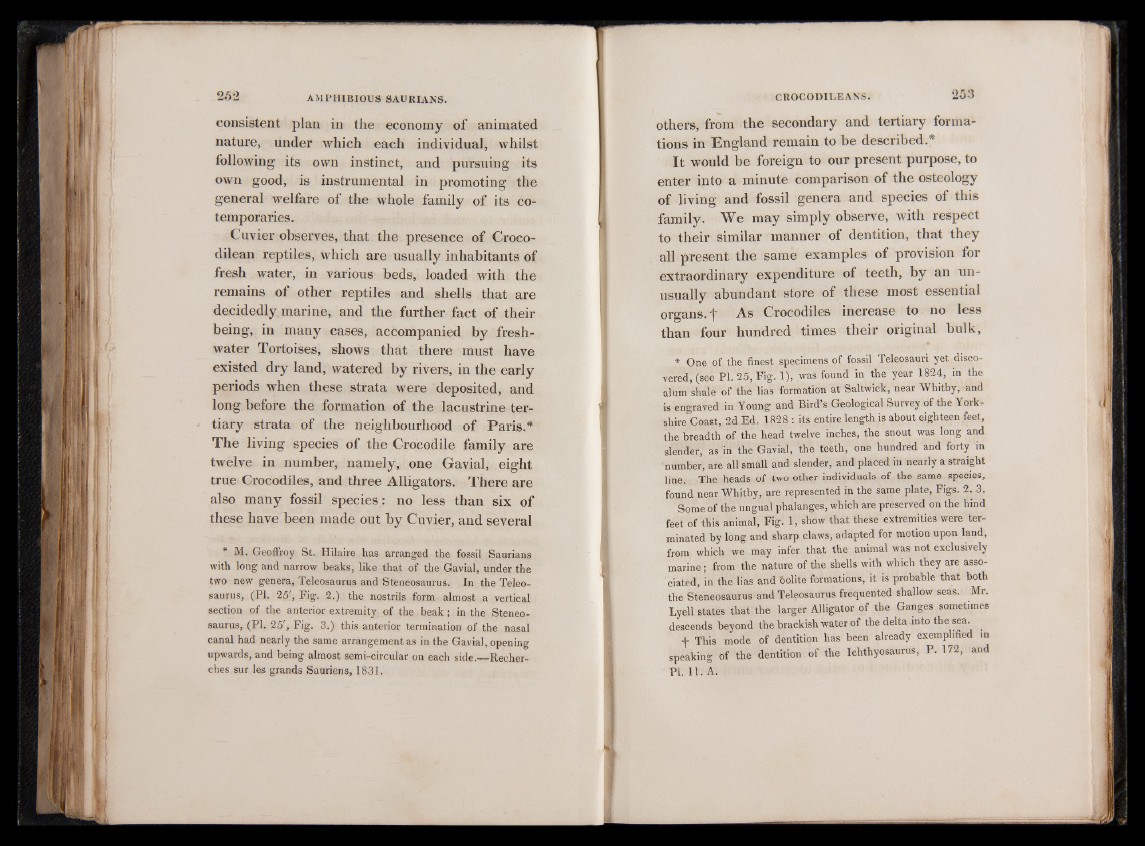
consistent plan in the economy of animated
nature, under which each individual, whilst
following its own instinct, and pursuing its
own good, is instrumental in promoting the
general welfare of the whole family of its cotemporaries.
Cuvier observes, that the presence of Croco-
dilean reptiles, which are usually inhabitants of
fresh water, in various beds, loaded with the
remains of other reptiles and shells that are
decidedly.marine, and the further fact of their
being, in many cases, accompanied by freshwater
Tortoises, shows that there must have
existed dry land, watered by rivers, in the early
periods when these strata were deposited, and
long before the formation of the lacustrine tertiary
strata of the neighbourhood of Paris.*
The living species of the Crocodile family are
twelve in number, namely, one Gavial, eight
true Crocodiles, and three Alligators. There are
also many fossil species: no less than six of
these have been made out by Cuvier, and several
* M. Geoffrey St. Hilaire has arranged the fossil Saurians
with long and narrow beaks, like that of the Gavial, under the
two new genera, Teleosaurus and Stfeneosaurus. In the Teleo-
saurus, (PI. 25', Fig. 2.) the nostrils form almost a vertical
section of the anterior extremity of the beak; in the Steneo-
saurus, (PI. 25', Fig. 3.) this anterior termination of the nasal
canal had nearly the same arrangement as in the Gavial, opening
upwards, and being almost semi-circular on each side.—Recher-
ches sur les grands Sauriens, 1831.
others, from the secondary and tertiary formations
in England remain to be described.*
It would be foreign to our present purpose, to
enter into a minute comparison of the osteology
of living and fossil genera and species of this
family. We may simply observe, with respect
to their similar manner of dentition, that they
all present the same examples of provision for
extraordinary expenditure of teeth, by an unusually
abundant store of these most essential
organs. ^ As Crocodiles increase to no less
than four hundred times their original bulk,
* One of the finest specimens of fossil Teleosauri yet discovered,
(see PI. 25, Fig. 1), was found in the year 1824, in the
alum shale of the lias formation at Saltwick, near Whitby, and
is engraved in Young and Bird’s Geological Survey of the Yorkshire
Coast, 2d Ed. 1828 : its entire length is about eighteen feet,
the breadth of the head twelve inches, the snout was long and
slender, as in the Gavial, the teeth, one hundred and forty in
number, are all small and slender, and placed in nearly a straight
line. The heads of two other individuals of the same species,
found near Whitby, are represented in the same plate, Figs. 2. 3.
Some of the ungual phalanges, which are preserved on the hind
feet of this animal, Fig. 1, show that these extremities were terminated
by long and sharp claws, adapted for motion upon land,
from which we may infer that the animal was not exclusively
marine; from the nature of the shells with which they are associated,
in the lias and oolite formations, it is probable that both
the Steneosaurus and Teleosaurus frequented shallow seas. Mr.
Lyell states that the larger Alligator of the Ganges sometimes
descends beyond the brackish water of the delta-into the sea.
f This mode of dentition has been already exemplified in
speaking of the dentition of the Ichthyosaurus, P. 172, and
PI. 11. A.